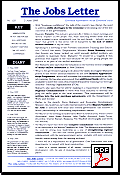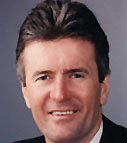



|
 |

|
| No.251 | 17 May 2006 | Essential Information on an Essential Issue |
of key events over the last few weeks. JOB NUMBERS AND UNEMPLOYMENT RATE BOTH UP WINZ “NEW SERVICE” ROLLED OUT MAORI TWICE AS LIKELY TO DIE FROM POOR HEALTH HEART DISEASE HIGHER AMONG THOSE ON LOW-INCOME … AND RESPIRATORY DISEASES PRISONER EMPLOYMENT SCHEMES MAY BE EXPANDED PETROL PRICES SHAPING THE ECONOMY PEOPLE WITH LARGE STUDENT DEBTS MORE LIKELY LIVING OVERSEAS LURING NZERS FROM AUSTRALIA VOLUNTEERS A “SERVICE-DELIVERY ARM” OF GOVERNMENT FREE PR FOR NOT-FOR-PROFIT GROUPS DAILY LIMITS FOR FREE EARLY CHILDHOOD EDUCATION FOREIGN STUDENT NUMBERS DECLINE ILLEGAL US RESIDENTS RALLY FOR RIGHTS PAUL HAWKEN WRITES OF A “BLESSED UNREST” STATISTICS THAT MATTER WHO GOT THE JOBS?  LAST Letter
LAST Letter
NEXT Letter   Download this issue as a PDF file
Index to Features
22 April 2006A joint Australia-NZ union campaign intends to put pressure on commercial building owners, their tenants and contractors to make more principled decisions when engaging commercial cleaning companies. "Clean Start — Fair Deal" aims to provide more secure jobs and better pay for the largely female immigrant commercial cleaning workforce. The initiative is supported by the Building Services Contractors of NZ which believes that improvements to cleaners' pay would address the high turnover rate and other issues in the highly competitive industry. Clean Start — Fair Deal has been launched in Auckland, Wellington and in the seven largest Australian cities. 24 April 2006NZ is not putting enough resources into attracting the thousands of South Korean students who would potentially come to NZ this year. While in South Korea Governor General Dame Silvia Cartwright says more promotion should be done to take advantage of the lower NZ$. The Indian PM Manmohan Singh asks Indian business managers to voluntarily commit to greater diversity in their workforce by hiring people from social castes they wouldn't normally consider. 48% of construction companies in Scotland report skill shortages according to a survey by the Royal Institution of Chartered Surveyors. 25 April 2006TVNZ is to axe up to 30 staff and not replace others who leave. The cuts will be primarily in the sales department and website unit. More Air NZ engineers have applied for volunteer redundancy than the company wants to dismiss. The Aviation and Marine Engineers Union explains there is bitterness and uncertainty in the wake of the airline's decision to reduce its engineering operations. In the US, factory workers who lose their jobs because their company shifts production to China are eligible for extended unemployment payments, Federal-funded re-training and relocation allowances. Factory workers have negotiated the same benefits that were already provided to computer programmes whose jobs are outsourced. 26 April 2006Telemarketers in Australia fear big job losses in the industry following the Federal government announcement of a "do not call" register to stop unwanted telemarketing calls. Telemarketing firm Contact 1-2-1 estimates the move could cost up to 30% of telemarketing jobs. Zimbabwe has the world's highest inflation rate (782%), unemployment above 70% and shortages of fuel, food and foreign currency. Hundreds of thousands of jobless Zimbabweans are fleeing to neighbouring South Africa and beyond. Africa is suffering from a brain drain, losing one third of its professionals to the developed world according to the UN Development Programme. 27 April 2006Feilding will lose 140 jobs when the McCains frozen vegetable plant closes down in December. Most potato products production will move to Timaru and specialty foods like hash browns will be imported from Australia. 1 May 2006Hong Kong is expected to be short of 100,000 skilled workers by 2007, according to its government. The price of oil edges up to $72/barrel. Oil costs $11 more per barrel than it did four months ago. 2 May 2006There were 8% fewer advertised job vacancies in March this year than there were a year ago. Even so, the March 2006 figures were 26% higher than they were in March 2003. The Job Vacancy Monitor - March 2006 can be downloaded from here. Many Australians are too busy at work to take their annual leave and one result is a downturn in local tourism. Tourism Australia is launching "No Leave, No Life" to encourage workers to take their estimated accrued 70 million annual leave days. 3 May 2006The Ministry of Justice publishes a legal opinion which shows the current Minimum Wage Law breaches the Bill of Rights. 5 May 2006The dollar amount of student loans repayments has dropped by 24% since interest free students loans for resident NZers came into effect a month ago, according to the IRD. An Australian Industry Group survey of employers found that skills shortages are a bigger challenge to Australian companies than the threat of competition or cheap foreign labour. 74% of those surveyed said that finding skilled staff is a barrier to their success. 6 May 2006The total number of beneficiaries in NZ fell by 8,374 over the last year. At the end of March there were 283,584 working aged people in receipt of a benefit. There are 117,831 (-29.4%) fewer working age New Zealanders on benefits than there were in 1999. 7 May 2006In March, the World Bank projected that by the end of 2006, 67% of the Palestinian population would be living in poverty and unemployment would reach 40%. The Bank "now considers these figures underestimates". Sanctions by the US and the EU, and Israel's refusal to release tax revenue to the Palestinian Authority has meant the Palestinian Authority has been unable to pay salaries to 165,000 public servants since March. 8 May 2006New Zealand will need to recruit 1,300 more scientists each year for the next decade if research investment is to meet targets according to AgResearch. Chief executive Andy West says the workforce needs to be more "science literate" to ensure there is enough talent to lead New Zealand research and development once current science leaders reach retirement age. West points out that more than half New Zealand's research workforce is 45 years or older and nearly 30% of scientists are 54 years or older. The Every Child Counts campaign is to continue. Organisers of the campaign — that was set up to persuade politicians during the 2005 election to make children central to government decision-making — say their purpose hasn't yet been achieved. The steering group says it will continue to apply the campaign's policy principles of placing children first in government planning, ensuring every child gets a good start, ending child poverty, and reducing child abuse and neglect. 11 May 200614 weeks of paid parental leave will be extended to include people who are self-employed from July this year. NZ drops from 16th to 22nd place in the World Competitiveness Yearbook compiled by the Swiss-based Institute for Management Development. The IMD identifies NZ's challenges as: improving internet broadband, encouraging skilled migrants, ensuring affordable energy and water, improving workplace productivity, improving management and business capability and reducing business compliance costs. 14 May 2006US president Bush proposed a plan to place up to 6,000 National Guard troops along the border with Mexico for at least a year to stem the influx of illegal immigrants. But he also urges Congress to address illegal immigration in a way that maintains the nation's "tradition of openness".
 LAST Diary
LAST Diary
NEXT Diary 
|
JOB NUMBERS AND UNEMPLOYMENT RATE BOTH UPThe workforce participation rate is now 68.5%, the highest rate ever recorded in this country. Statistics New Zealand attributes this to more women than ever joining the workforce and a rise in immigration over the period. But even with all the new jobs, the unemployment rate has risen from 3.6% to 3.9%. There were 8,000 more people unemployed and Statistics New Zealand says this increase has been because the large number of people (30,000) looking for work outstripped the number of new jobs. Bank of New Zealand economist Craig Ebert says that while the rise in unemployment gave a sense
that the labour market had finally peaked, the tight labour market would be slow in easing.
We include our regular — the quarterly growth in jobs was entirely due to a rise in full-time employment — for the year, the number of jobs in the economy grew by 2.6%. — Maori unemployment has risen from 7.6% to 8.7% — New Zealand has the second lowest unemployment rates in the OECD
Source — Household Labour Force Survey March 2006; Dominion Post, 12 March 2006, "Dole queue grows as job numbers rise" by James Weir; New Zealand Herald, 12 March 2006, "Growing workforce hits hob figures" by Brian Fallow.
WINZ "NEW SERVICE" ROLLED OUT Work & Income has changed its case management approach to one that puts the initial focus
on getting all clients into a job rather than determining what sort of benefit entitlement they might have.
This new service model applies not only to people who are unemployed but also to people who are likely
to be eligible for a Domestic Purposes, Sickness or Invalid's Benefit. Minister of Social Development
and Employment David Benson-Pope says the new service has been trialled for a year in 12 centres
and during that time 90% of those who had been offered the new job-focused service took it up. The
trial also found that as many as one-in-five people receiving benefits other than the unemployment
benefit identified themselves as able to work. Work & Income will now treat all people who register with it
as potential job seekers. Work & Income has changed its case management approach to one that puts the initial focus
on getting all clients into a job rather than determining what sort of benefit entitlement they might have.
This new service model applies not only to people who are unemployed but also to people who are likely
to be eligible for a Domestic Purposes, Sickness or Invalid's Benefit. Minister of Social Development
and Employment David Benson-Pope says the new service has been trialled for a year in 12 centres
and during that time 90% of those who had been offered the new job-focused service took it up. The
trial also found that as many as one-in-five people receiving benefits other than the unemployment
benefit identified themselves as able to work. Work & Income will now treat all people who register with it
as potential job seekers.
Initially the new service will be offered only to new clients but will be extended to existing clients from September this year. For the first time, all Work & Income clients, including those eligible for Domestic Purposes, Sickness or Invalid's Benefits, will be offered: —a pre-assessment of their circumstance, needs and work readiness — WRK4U seminars that provide information on local labour market conditions, vacancies, employment services and income support entitlements and responsibilities — information, planning and preparation seminars for people who want to work but are unable to do so immediately because of constraints like caring responsibilities or illness — access to work brokers who link jobseekers with employers through jobz4u profiles — better and earlier access to employment programmes including job subsidies and training. 
Benson-Pope expects the new service will result in Domestic Purposes, Sickness and Invalid's Benefit clients being on a benefit for shorter lengths of time before moving into full-time work. He also predicts more beneficiaries would increase their earnings by taking up part-time work while still on a benefit.
Source— Media release NZ government by David Benson-Pope, 27 May 2006, "Getting people into the right job, at the right time, right from the start"; Media release NZ government by David Benson-Pope, 27 May 2006, "Launch of Work and Income's new service approach.MAORI TWICE AS LIKELY TO DIE FROM POOR HEALTHAmong the socio-economic factors, a key variable is employment. This fits with the large increases in unemployment in the late 1980s and early 1990s that impacted disproportionately upon Maori. Decades of Disparity III authors say the findings reinforce the need to take both socio-economic position and ethnicity into account in health funding formulas and that there needs to be a sustained long-term commitment from government to help reduce inequalities between ethnic groups. co-author Tony Blakely. "That's why we're looking for a sustained political commitment not just from the present government but from successive governments to ensure that both ethnicity and socio-economic status continue to factor in the funding of health programmes."
Source — Media release University of Otago, 8 May 2006, "Socio-economic status half the story in ethnic death rate differences"; media release New Zealand Government by Pete Hodgson, 8 May 2006, "Employment key in reducing health inequalities".
HEART DISEASE HIGHER AMONG THOSE ON LOW-INCOMESSource — Dominion Post, 21 April 2006, "'Alarming' rise in heart disease death rates" _ NZPA
… AND RESPIRATORY DISEASESCo-editor Innes Asher says that income has long been widely recognised as the most important health determinant. The cumulative effects of long-term inadequate nutrition, crowded substandard housing and living conditions, and unaffordable or inaccessible primary health care over the last 15-20 years have taken a lasting toll on the health of hundreds of thousands of New Zealand children. Asher: "New Zealand children have very high rates of preventable diseases and injury compared with other similar countries like the UK and Australia, which have more generous economic support for families with children. Until the poor economic situation of New Zealand children in poverty is addressed, this alarming situation is likely to continue into the next decades. The report's 36 key recommendations include introducing an obligation on the government to monitor and report on child poverty and creating strategies and a time-line to reduce and eliminate child poverty. It also calls to strengthen the New Zealand housing strategy to provide sufficient resources to enable universal access for children to uncrowded, insulated and affordable housing. It also recommends that resources be provided for the easily accessible, free primary health care, 24 hours per day, seven days per week, and free prescriptions for children and young people.
PRISONER EMPLOYMENT SCHEMES MAY BE EXPANDED The government aims to get 60% of prisoners into work or training according to its
Prisoner Employment Strategy. The plan is to re-establish nursery, horticulture and community
work-gang projects which had been axed in recent years (see
Jobs Letter No 247). Other initiatives include
plans to encourage industries to adopt prisoner training initiatives both inside and outside prisons. Minister
of Corrections Damien O'Connor says the intention is to reduce prisoner re-offending by increasing
the use of employment, vocational and drug and alcohol programmes. He says the importance of
prisoner employment is obvious given that less than half of sentenced prisoners had paid jobs before
entering prison. The government aims to get 60% of prisoners into work or training according to its
Prisoner Employment Strategy. The plan is to re-establish nursery, horticulture and community
work-gang projects which had been axed in recent years (see
Jobs Letter No 247). Other initiatives include
plans to encourage industries to adopt prisoner training initiatives both inside and outside prisons. Minister
of Corrections Damien O'Connor says the intention is to reduce prisoner re-offending by increasing
the use of employment, vocational and drug and alcohol programmes. He says the importance of
prisoner employment is obvious given that less than half of sentenced prisoners had paid jobs before
entering prison.
Source — New Zealand Herald, 12 May 2006, "Plan for more work and fewer prisoners" by Ruth Berry; Media release, NZ govt by Damien O'Connor, 11 May 2006, "New strategy to get more prisoners into work"; Media release National Party, 11 May 2006, "Prisoner work strategy a load of waffle".PETROL PRICES SHAPING THE ECONOMY Higher petrol prices will be a "powerful force" affecting New Zealanders' consumer
spending and will slow the economy according to ANZ Bank economists. The bank expects the
domestic economy to turn "decidedly negative" this month primarily due to petrol price hikes. When petrol
rose above $1.50 per litre in September 2005, demand for cars collapsed and household
spending diminished. Petrol is now above $1.70 per litre. Higher petrol prices will be a "powerful force" affecting New Zealanders' consumer
spending and will slow the economy according to ANZ Bank economists. The bank expects the
domestic economy to turn "decidedly negative" this month primarily due to petrol price hikes. When petrol
rose above $1.50 per litre in September 2005, demand for cars collapsed and household
spending diminished. Petrol is now above $1.70 per litre.
Source — Dominion Post, 25 April 2006, "Petrol blues hit confidence" by James Weir; CTU Monthly Economic Bulletin No 68 (April 2006).STUDENT DEBTSOther conclusions drawn by the study include that borrowers who had attained higher qualifications are more likely to be living overseas. People who studied at the doctoral level were the most likely to be overseas while those who had studied at institutes of technology and polytechnics were less likely to be overseas. Borrowers older than age 35 were less likely to be overseas five years after leaving study than those younger. And Maori and Pasifika borrowers were less likely than their European counterparts to be overseas.
Source — media release NZ govt, 2 May 2006 "Loans one of many factors driving student OE"LURING NZERS FROM AUSTRALIADepartment of Labour research shows that New Zealanders who have been living in Australia for more than two years tend to lose touch with what is going on back home. The Minister of Immigration David Cunliffe says New Zealand Now is about creating awareness about the changing New Zealand lifestyle and employment opportunities. Cunliffe: "These people are an ideal source of talent to sustain economic growth and to help employers who are crying out for skilled people. We need these people to ensure continued economic growth in this country." — The New Zealand Now campaigned website can be found here. Source — Media release New Zealand Government by David Cunliffe, 11 May 2006, "Expat programme expands to Kiwis in Australia"; Media release National Party by John Key, 11 May 2006, "Labour whistling in wind over expat campaign"; Media release Department of Labour, 11 May 2006, "Expats programme moves to Australia".VOLUNTEERS "SERVICE-DELIVERY ARM" OF GOVERNMENT If the New Zealand voluntary sector shut down, key infrastructure would probably
collapse according to visiting Canadian Bob Wyatt of the Muttart Foundation. Wyatt points out there is
an estimated 60,000 voluntary organisations in New Zealand that provide a huge range of services,
many of whom support government policy or deliver government programmes. Wyatt says that without
this voluntary sector, the government couldn't afford to deliver key services. He says every
dollar provided to a voluntary agency typically delivers $3 -$5 of services to the community. If the New Zealand voluntary sector shut down, key infrastructure would probably
collapse according to visiting Canadian Bob Wyatt of the Muttart Foundation. Wyatt points out there is
an estimated 60,000 voluntary organisations in New Zealand that provide a huge range of services,
many of whom support government policy or deliver government programmes. Wyatt says that without
this voluntary sector, the government couldn't afford to deliver key services. He says every
dollar provided to a voluntary agency typically delivers $3 -$5 of services to the community.
Wyatt says that despite the dependence of the government on community organisations, it takes little if any notice of the impact that legislation or events, such as spiralling fuel costs, have on the voluntary sector. He says both sides need to sit down and listen to one another to create better efficiencies and services. Source — Dominion Post, 3 May 2006, "Volunteers `keep country from collapse'", by Anna Chalmers.FREE PR FOR NOT-FOR-PROFIT GROUPS A website is up and running that is designed to help community service organisations
get professional assistance to develop their public relations campaign. AdAid provides a place where community groups can meet with
agencies who are capable doing such work — and are willing do it pro bono as part of their own
community service. A website is up and running that is designed to help community service organisations
get professional assistance to develop their public relations campaign. AdAid provides a place where community groups can meet with
agencies who are capable doing such work — and are willing do it pro bono as part of their own
community service.
AdAid provides community groups with a process it calls AA101 that helps them create a clear outline of what they want to achieve in terms of their public identity, advertising campaign, website or promotional campaign. Once AdAid assesses the outline as being of a standard that an ad agency would expect of any commercial client — it is uploaded to the AdAid website. From there it can be viewed by participating advertising and communications agencies who may select briefs that interests them. The agency then makes contact with the community group about taking on the project. If both decide to go ahead, the project can proceed just like any commercial project the agency would do. Once complete, the advertising agency contacts appropriate media organisations in order to get the advertising or promotional campaign out in front of the public.
DAILY LIMITS FOR FREE EARLY CHILDHOOD EDUCATIONBut not everyone does agree. Early Childhood Council chief executive Sue Thorne says she can't understand the rationale behind the decision to have a daily maximum. If a parent wants to work two eight-hour days, they will not get the full subsidy, but if they works four days a week, they will. Thorne points out that some employers are flexible, but the six-hour limit will penalise those people whose employers are not. Source — Dominion Post, 29 April 2006, "Strings attached to free childcare" by Sophie Neville and Kristi Gray
FOREIGN STUDENT NUMBERS DECLINEThe Ministry of Tourism says the drop in foreign student numbers cost the economy even more — its figures showed a 39% ($438 million) drop in spending by international students and their families. Even so, foreign students contributed $1.89 billion to the New Zealand economy in 2005 making the industry New Zealand's third largest export earner, only behind tourism and dairy. However, French is concerned about the lack of resources behind the promotion to increase Korean student numbers. He says Australia puts much greater resources into attracting foreign students than does New Zealand. Source — New Zealand Herald, 4 May 2006, "Earnings from foreign students at three-year low" by Stuart Dye; Dominion Post, 3 May 2006 2006, "Foreign students spend $280m less" by Sue Allen; Dominion Post, 25 April 2006, "Fall in dollar may lure more students" by Dan Eaton and Rebecca Palmer.
ILLEGAL US RESIDENTS RALLY FOR RIGHTS May Day in the United States saw an estimated one million illegal Hispanic migrants and
their supporters walk off their jobs. "A Day Without Immigrants" saw factories closed, few workers
filling casual labouring day-jobs, restaurants stripped of staff and school children staying away from school
in order to join marches on city halls and state capitals across the country. The demonstrations not
only called attention to the magnitude of the illegal immigrant numbers, it also illustrated how
fundamental their labour is to the running of the country. There is an estimated 11-12 million illegal immigrants in
the United States — and most of them are working. May Day in the United States saw an estimated one million illegal Hispanic migrants and
their supporters walk off their jobs. "A Day Without Immigrants" saw factories closed, few workers
filling casual labouring day-jobs, restaurants stripped of staff and school children staying away from school
in order to join marches on city halls and state capitals across the country. The demonstrations not
only called attention to the magnitude of the illegal immigrant numbers, it also illustrated how
fundamental their labour is to the running of the country. There is an estimated 11-12 million illegal immigrants in
the United States — and most of them are working.
The demonstrations come at a time when there are two contradictory Bills before the Congress. One would make just being illegally in the United States a felony offence. The other would create a guest worker programme that would allow illegal immigrants a chance to earn US citizenship. Source — Dominion Post, 2 May 2006, "Immigrants flex economic muscle in US", Reuters; Source - New Zealand Herald, 3 May 2006, "US immigration impasse remains despite protests" by Donna Smith
PAUL HAWKEN WRITES OF A "BLESSED UNREST" American entrepreneur Paul Hawken is soon to publish his latest book
"Blessed Unrest" (Viking/Penguin 2006) and release a film documentary of the same name. In the book,
Hawken suggests that the world is seeing the beginning of a new type of movement for civil society
— composed of hundreds of thousands of community and not-for-profit groups and social entrepreneurs. American entrepreneur Paul Hawken is soon to publish his latest book
"Blessed Unrest" (Viking/Penguin 2006) and release a film documentary of the same name. In the book,
Hawken suggests that the world is seeing the beginning of a new type of movement for civil society
— composed of hundreds of thousands of community and not-for-profit groups and social entrepreneurs.
Hawken's Natural Capital Institute has done research which shows that millions of people with shared sets of values are involved in countless organizations that address social justice, ecological sustainability and indigenous rights in the broadest sense of those terms. The New York Times has dubbed this worldwide movement "the Other Superpower"— which may be a belated recognition of a phenomenon that is emerging on a scale unseen in human history, and is changing the very nature of civil society. And the power of this movement is that it is not directed. Hawken: "These hundreds of thousands of groups are beginning to morph, unknowingly, into the world's largest social and political movement … it represents humanity's immune response to political corruption, economic disease and ecological degradation. It is hard to say how big it is … it is a movement that doesn't know that it's a movement..."
Source — Paul Hawken website at www.naturalcapital.org; also interview with Paul Hawken in Value, Vol 1 Issue 1 (16 April 2006) |